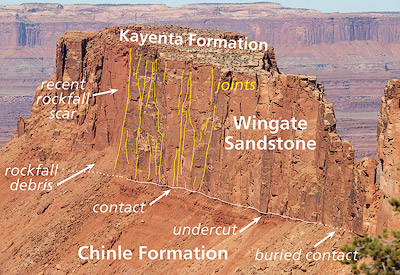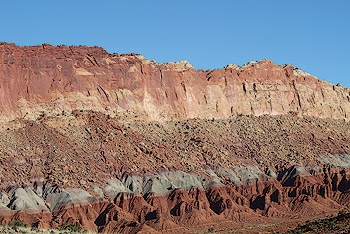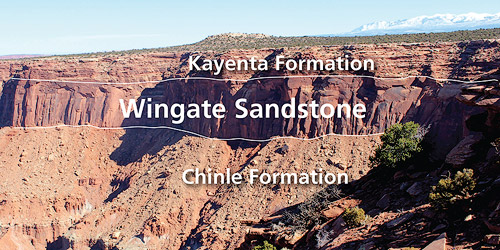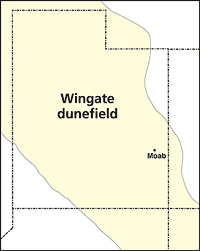 |
| Typical features of a Wingate Sandstone cliff face. Steep nearly-vertical slope made of Wingate Sandstone with prominent vertical jointing. The Wingate-Chinle contact is clear except where it has been buried by rock fall debris. Small overhangs of Wingate Sandstone are formed when the more rapidly eroding Chinle Formation undercuts the Wingate leading to rock falls. A recent rock fall scar shows that the area where the rockfall occurred is bounded by joints, revealing the role of jointing in the mechanical erosion of the cliff face. The contact with the overlying Kayenta Formation is harder to discern. |
The Wingate Sandstone is one of the most iconic rock layers (formations to geologists) in all of southeastern Utah. This rock layer has an especially prominent role in forming the region’s landscape as it is the most dramatic cliff-maker in canyon country, forming nearly vertical slopes nearly everywhere where it is exposed.
The inventory of Wingate Sandstone cliffs in southeastern Utah is particularly impressive:
The dark-red cliffs above Moab and along the Colorado River, especially along the River Road (Highway 128).
· The cliffs surrounding Canyonlands National Park, including the Orange Cliffs west of the park and the Indian Creek area to the east.
· Canyonlands’ Island in the Sky and Deadhorse Point State Park.
· The cliffs above historic Fruita and the Scenic Drive in Capitol Reef National Park.
· The eponymous Bears Ears of Utah’s newest national monument.
· The Circle Cliffs and the San Rafael Swell, both west of Moab.
· The sheer cliffs of Colorado National Monument near Grand Junction.
The reason that the Wingate Sandstone usually forms steep cliffs is a result of its own characteristics, as well as those of the rock units below and above it. The Wingate Sandstone is resistant to erosion. It is massive, made up of fine sand grains of nearly uniform size, and strongly cemented making it hard and giving it the ability to make smooth walls. Hard sandstones like the Wingate have the strength to maintain rock slopes of more than 80 degrees from horizontal.
 |
| Wingate Sandstone cliffs in Capitol Reef National Park. |
The Wingate is capped by an even harder sandstone, the Kayenta Formation. In actuality, the upper portion of nearly every Wingate cliff face is made of the Kayenta Formation. The Kayenta was deposited in sandy rivers that left thin beds of sandstone. The contact (boundary) between the Wingate and the Kayenta is usually hard to identify, but typically it is where the sheer cliff face becomes ledgey with observable bedding planes.
The Chinle Formation underneath the Wingate Sandstone is drastically different from the two sandstones. The Chinle consists of colorful bands of mudstone and thin sandstone beds deposited by rivers and on their floodplains. Overall, the Chinle Formation erodes readily compared to the harder overlying rocks. Through time, the more rapidly eroding Chinle Formation can actually undercut the Wingate, leading to rockfalls, rock avalanches, and other mass wasting events as the cliff erode and retreat. Debris from these rockfalls frequently covers the Chinle Formation so that actual outcrops of it are relatively rare.
Another feature of the Wingate Sandstone that plays a critical role in the formation of its characteristic cliffs is that the unit is usually cut by a series of vertical fractures, known as joints. Joints form in rocks as a result of accumulated geologic stress. A rock layer must have a certain strength in order to accumulate enough stress in order to fracture. Weak rock layers like the Chinle usually aren’t jointed because they deform before large fractures can occur.

The fractures in the Wingate Sandstone are classified as release joints which form when rock layers get closer to the Earth’s surface due to uplift and erosion, such as what has occurred on the Colorado Plateau (the greater Four Corners area) during the last 70 million years. Erosion of overlying rock units decreases the amount of compression that a layer experiences within the Earth and cools it causing contraction. Together, these forces cause tensile stress that can fracture hard rock layers.
The joints in the Wingate Sandstone also serve a recreational purpose. They have made the Indian Creek area south of Moab one of the premiere crack climbing spots in the world.
 The story of the Wingate’s origin is deeply different than its modern role of cliff-former. The Wingate Sandstone was deposited about 200 million years ago at the end of the Triassic and the beginning of the Jurassic periods in a sand dune environment. These sand dunes covered most of the state of Utah with the exception of the far southwest and northeast corners. The story of the Wingate’s origin is deeply different than its modern role of cliff-former. The Wingate Sandstone was deposited about 200 million years ago at the end of the Triassic and the beginning of the Jurassic periods in a sand dune environment. These sand dunes covered most of the state of Utah with the exception of the far southwest and northeast corners.
The Wingate Sandstone is between about 300 and 500 feet thick throughout southeastern Utah. Because of its vertical nature, most people (except rock climbers) who explore canyon country don’t usually get to observe the Wingate Sandstone up close to see the fine features in it that tell of its ancient sand dune environment during the age of the Dinosaurs. But everyone can be a connoisseur of the Wingate Sandstone from afar and admire its vertical cliffs, vertical joint sets, and deep red color.
|